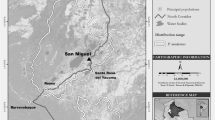Summary
The frequency of looking up was scored as a measure of vigilance behavior in two species of African forest monkeys (genus Cercopithecus) that often associate in mixed-species groups. The fact that looking up decreased with increasing foliage density around focal individuals was taken as evidence that looking up is an expression of vigilance for predators. The rate of looking up was higher in single-species groups than in mixed species groups for both species. Association had a more marked effect on the rate of looking up when monkeys fed on plant material as opposed to insects. The adjustment of the rate of looking up with respect to association status does not reflect the presence or absence of other monkeys in the same feeding tree. Although a reduction in vigilance levels probably leads to increased feeding efficiency, it is not a sufficient explanation of mixed-species association in the species under study.
Similar content being viewed by others
References
Abramson M (1979) Vigilance as a factor influencing flock formation among curlews Numenius arquata. Ibis 121:213–216
Barnard CJ (1980) Flock feeding and time budgets in the house sparrow (Passer domesticus L.). Anim Behav 28:295–309
Barnard CJ, Stephens H (1983) Costs and benefits of single and mixed species flocking in fieldfares (Turdus pilaris) and redwings (T. iliacus). Behaviour 84:91–123
Berger J (1978) Group size, foraging, and anti-predator plays: an analysis of bighorn sheep decisions. Behav Ecol Sociobiol 4:91–99
Bertram BCR (1978) Living in groups: predators and prey. In: Krebs JR, Davies NB (eds) Behavioural ecology. Blackwell, Oxford, pp 64–96
Bertram BCR (1980) Vigilance and group size in ostriches. Anim Behav 28:278–286
Caraco T (1979) Time budgeting and group size: a test of theory. Ecology 60:618–627
Cords M (1987) Mixed-species association of Cercopithecus monkeys in the Kakamega Forest, Kenya. Univ Calif Publ Zool 117:1–109
Dunbar RIM (1988) Primate social systems. Croon Helm, London Sydney
Elgar MA, Catterall CP (1981) Flocking and predator surveillance in house sparrows: test of an hypothesis. Anim Behav 29:868–872
Gautier-Hion A (1988) Polyspecific associations among forest guenons: ecological, behavioural and evolutionary aspects. In: Gautier-Hion A, Bourliere F, Gautier JP, Kingdon J (eds) A primate radiation: evolutionary biology of the African guenons. Cambridge University Press, Cambridge, pp 452–476
Gautier-Hion A, Tulin CEG (1988) Simultaneous attack by adult males of a polyspecific troop of monkeys against a crowned hawk eagle. Folia Primatol 51:149–151
Gautier-Hion A, Quris R, Gautier JP (1983) Monospecific vs. polyspecific life: a comparative study of foraging and antipredatory tactics in a community of Cercopithecus monkeys. Behav Ecol Sociobiol 12:325–335
Hauser MD, Wrangham RW (1988) How are prey predator-wise? Paper presented at the XIIth Congress of the International Primatological Society, Brasilia, Brazil, 24–29 July 1988
Hoogland JL (1979) The effect of colony size on individual alertness of prairie dogs (Sciuridae: Cynomys spp.). Anim Behav 27:394–407
Lazarus J (1978) Vigilance, flock size and domain of danger in the white fronted goose. Wildfowl 29:135–145
Lazarus J (1979) Flock size and behaviour in captive red-billed weaverbirds (Quelea quelea): implications for social facilitation and the functions of flocking. Behaviour 71:127–145
Lipetz VE, Bekoff M (1982) Group size and vigilance in pronghorns. Z Tierpsychol 58:203–216
Metcalfe NB (1984) The effects of mixed-species flocking on the vigilance of shorebirds: who do they trust? Anim Behav 32:986–993
Parker GA, Hammerstein P (1985) Game theory and animal behaviour. In: Greenwood PJ, Harvey P, Slatkin M (eds) Evolution: essays in honor of John Maynard Smith. Cambridge University Press, Cambridge, pp 73–94
Powell GVN (1974) Experimental analysis of the social value of flocking by starlings (Sturnus vulgaris) in relation to predation and foraging. Anim Behav 22:501–505
Pulliam HR (1973) On the advantages of flocking. J Theor Biol 38:419–422
Pulliam HR, Caraco T (1984) In: Krebs JR, Davies NB (eds) Behavioural ecology. Blackwell, Oxford, pp 122–147
de Ruiter JR (1986) The influence of group size on predator scanning and foraging behaviour of wedgecapped capuchin monkeys (Cebus olivaceus). Behaviour 98:240–258
Siegfried WR (1980) Vigilance and group size in springbok. Madoqua 12:151–154
Struhsaker TT (1981) Polyspecific associations among tropical rainforest primates. Z Tierpsychol 57:268–304
Sullivan KA (1985) The advantages of social foraging in downy woodpeckers. Anim Behav 32:16–22
Author information
Authors and Affiliations
Rights and permissions
About this article
Cite this article
Cords, M. Vigilance and mixed-species association of some East African forest monkeys. Behav Ecol Sociobiol 26, 297–300 (1990). https://doi.org/10.1007/BF00178323
Received:
Accepted:
Issue Date:
DOI: https://doi.org/10.1007/BF00178323




